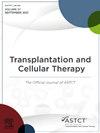Leukocyte Telomere Shortening in Recipients after Hematopoietic Cell Transplant and Its Association with Factors That Affect Recipient Outcomes: An Analysis of BMT CTN Protocol 1202
IF 3.6
3区 医学
Q2 HEMATOLOGY
引用次数: 0
Abstract
Introduction
Leukocyte telomere length (LTL) significantly shortens after hematopoietic cell transplant (HCT) because of hematopoietic cell proliferation to achieve engraftment and immune reconstitution. The magnitude of LTL shortening is associated with patient outcomes after HCT. Limited LTL shortening is associated with increased relapse risk, and excess LTL shortening is associated with higher risk of non-relapse mortality.
Objective
This study aimed to identify factors associated with LTL shortening in the first three-months after HCT.
Methods
We studied 916 HCT recipients from the Blood & Marrow Transplant Clinical Trial Network 1202 Protocol who had donor blood samples available in the CIBMTR Biorepository. Southern blotting was used to measure LTL in donor pre-HCT and recipient post-HCT samples (average of 90 days). LTL shortening was calculated as donor mean LTL – recipient mean LTL. We examined LTL as a continuous outcome and in categories (limited LTL shortening: <25th percentile vs ≥25th percentile; excess LTL shortening: >75th percentile vs ≤75th percentile). We explored bivariate associations between LTL and donor, recipient, and clinical and transplant characteristics and included variables with P<0.1 in final multivariable linear and logistic regression models.
Results
Multiple linear regression models found an association between less LTL shortening and older donor age (P<0.001) and peripheral blood (PB) vs bone marrow (BM) graft (P=0.001). In logistic regression models, older donor age (P<0.001); PB vs BM graft (P=0.003); female vs male donors (P=0.019); and lymphoid vs myeloid disease (P=0.039) were significantly associated with a higher likelihood of limited LTL shortening. Older recipient age (P=0.001); receiving Busulfan-Cyclophosphamide (Bu/Cy; P=0.046) and total body irradiation (TBI; P<0.001) conditioning regimens vs Busulfan-Fludarabine (Bu/Flu); and receiving antithymocyte globulin (ATG) or Campath (P=0.01) vs not receiving ATG or Campath were associated with a lower likelihood of limited LTL shortening (Figure 1).
More LTL shortening was associated with older recipient age (P= 0.01) and conditioning regimens with Bu/Cy (P=0.02) and TBI (P<0.001) vs Bu/Flu regimens. Having African American (AA) vs non-Hispanic white (NHW) donors (P=0.045); receiving T-cell depletion vs calcineurin-inhibitor/methotrexate (MTX)-based GVHD prophylaxis regimens (P=0.028); and TBI-based vs Bu/Flu conditioning regimens (P<0.001) were associated with higher likelihood of excess LTL shortening (Figure 2).
Conclusion
This study identifies several factors associated with post-HCT telomere length shortening, which may affect recipient outcomes.
求助全文
约1分钟内获得全文
求助全文
来源期刊

Transplantation and Cellular Therapy
Medicine-Hematology
CiteScore
7.00
自引率
15.60%
发文量
1061
审稿时长
51 days
 求助内容:
求助内容: 应助结果提醒方式:
应助结果提醒方式:


